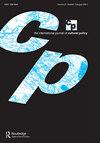Arts and cultural management: sense and sensibilities in the state of the field
IF 1.6
3区 社会学
Q2 CULTURAL STUDIES
引用次数: 0
Abstract
aspects of cultural work during the pandemic. Overall, the chapters repeatedly point out the problems of creative freelancing – low earning, the lack of access to social safety, portfolio career, prevailing uncertainty, the individualised risk, short-term contract and so on – which were exacerbated. At the same time, some chapters note how artists and cultural workers adapted to the crisis by reflecting on their existing work pattern and organisation, embracing the digital technology and online media, building resilience and taking a contemplative mode. Yet, another key observation is the deepening of the structural inequality which is manifested by the disproportionate impacts of the pandemic on freelancers and the workers with less privileged backgrounds. Part 3 examines ‘institutional strategies’. Broadly speaking, the chapters in this part are about cultural organisations, cultural industries in general and film agencies, and their responses to Covid. Countries and regions covered include Italy, Spain, the Nordic region, Czech Republic and the European region. One common theme cutting across the chapters is the (potential) structural changes triggered by the pandemic in the cultural industries in general and the museum, film and orchestra sectors in particular. The changes include the shift to the digital, more focus on local provision, more engagement with the community, new relationship with audience across online and offline, new business model and the rise of streaming services. From this, we need to ask some important questions regarding the future of cultural policy: what kind of policies or state interventions would facilitate those changes; how the existing organisations and venues can adapt; and under what conditions the changes will create new opportunities for cultural workers or make their work even more precarious. Over the past 2 years, a number of writings examining the cultural sector during the pandemic have been published in journals such as IJCP or Cultural Trends. This edited volume adds diverse case studies to the current literature. Its biggest merits are the focused overview of the cultural industries during the Covid crisis, the coverage of several European countries and the country-specific details. Yet, comparative approach could be more consciously and explicitly attempted. This book helped me find some answers to my questions on what happened, who were affected and what policymakers did during the viral emergency whilst my other questions remain unanswered. Many of us are currently engaged in the collective endeavours to produce new knowledge of cultural policy in the Covid and post-Covid contexts. A significant part of these endeavours is to analyse if and how the experience of the pandemic informs and reshapes the mission, reasoning, scope, structure, institutional arrangement and instruments of cultural policy for tomorrow. This book’s empirical data and findings feed well into such efforts.艺术文化管理:感性与感性领域的状态
大流行期间文化工作的各个方面。总体而言,这些章节反复指出了创造性自由职业的问题——收入低、缺乏社会保障、组合职业、普遍存在的不确定性、个性化风险、短期合同等等——这些问题都加剧了。与此同时,书中的一些章节还提到了艺术家和文化工作者是如何通过反思他们现有的工作模式和组织、拥抱数字技术和在线媒体、建立韧性和采取沉思模式来适应危机的。然而,另一个重要的观察结果是,结构性不平等的加深,这表现为疫情对自由职业者和背景较差的工人造成了不成比例的影响。第三部分考察了“制度战略”。从广义上讲,这一部分的章节是关于文化组织,一般文化产业和电影机构,以及他们对Covid的反应。覆盖的国家和地区包括意大利、西班牙、北欧地区、捷克共和国和欧洲地区。贯穿各章节的一个共同主题是疫情在整个文化产业,特别是博物馆、电影和管弦乐队部门引发的(潜在的)结构性变化。这些变化包括向数字化的转变、更多地关注本地供应、更多地参与社区、与线上和线下观众建立新的关系、新的商业模式以及流媒体服务的兴起。由此,我们需要问一些关于未来文化政策的重要问题:什么样的政策或国家干预会促进这些变化;现有的机构和场地如何适应;在什么条件下,这些变化将为文化工作者创造新的机会,还是使他们的工作更加不稳定。在过去两年中,在诸如《国际联合期刊》或《文化趋势》等期刊上发表了一些研究大流行期间文化部门的文章。这个编辑卷增加了不同的案例研究,以当前的文献。它最大的优点是对新冠肺炎危机期间的文化产业进行了重点概述,对几个欧洲国家的报道以及具体国家的细节。然而,比较方法可以更有意识和明确地尝试。这本书帮助我找到了一些问题的答案,如发生了什么,谁受到了影响,政策制定者在病毒紧急情况下做了什么,而我的其他问题仍未得到解答。我们中的许多人目前正在共同努力,为新冠疫情和后疫情背景下的文化政策提供新的知识。这些努力的一个重要部分是分析大流行病的经验是否以及如何影响和改变未来文化政策的使命、推理、范围、结构、体制安排和工具。这本书的实证数据和发现很好地支持了这种努力。
本文章由计算机程序翻译,如有差异,请以英文原文为准。
求助全文
约1分钟内获得全文
求助全文

 求助内容:
求助内容: 应助结果提醒方式:
应助结果提醒方式:


